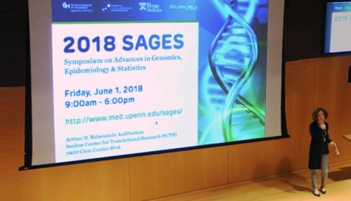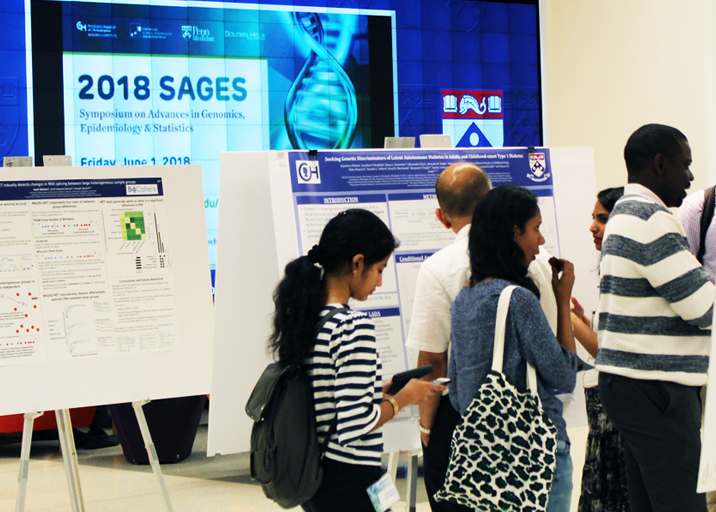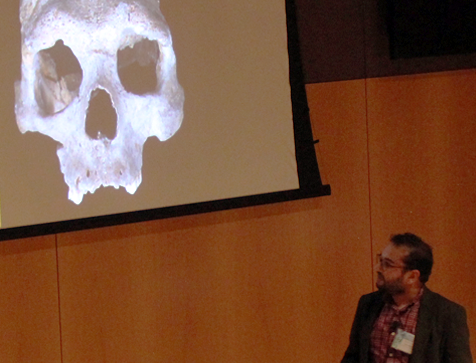HOW CAN WE HELP YOU? Call 1-800-TRY-CHOP
In This Section
Bring on the Noise: Genomics Experts Think Through Big Data at SAGES
 The Symposium on Advances in Genomics, Epidemiology and Statistics (SAGES) has a winning formula for success: Bring together an interdisciplinary group of scientists who are all working toward the same goal of understanding the genetic basis of human disorders. Close to 200 SAGES attendees gathered June 1 at the Smilow Center for Translational Research for a dynamic opportunity to explore a wealth of ideas and make connections with colleagues from diverse areas of expertise.
The Symposium on Advances in Genomics, Epidemiology and Statistics (SAGES) has a winning formula for success: Bring together an interdisciplinary group of scientists who are all working toward the same goal of understanding the genetic basis of human disorders. Close to 200 SAGES attendees gathered June 1 at the Smilow Center for Translational Research for a dynamic opportunity to explore a wealth of ideas and make connections with colleagues from diverse areas of expertise.
“We are quite excited by the strong interest in this event from both within and outside the CHOP and Penn communities, as well as from participants from the biotech and pharmaceutical sectors,” said Marcella Devoto, PhD, chair of the symposium’s organizing committee. “One of the goals of the symposium is to encourage discussion among scientists of different backgrounds who want to know more about computational methods that can help identify the causes of complex disease.”
Dr. Devoto is a scientist in the Division of Human Genetics at CHOP, and a professor of Pediatrics, Genetics, and Epidemiology at the Perelman School of Medicine at the University of Pennsylvania. She began the symposium six years ago, and its growth in size and scope — with the support of a National Human Genome Research Institute grant — reflects the rapid progress in genomics and other omics disciplines.
 This year’s program included nine speakers and two poster sessions that shared researchers’ new approaches to sifting through the vast amount of noisy data produced by next-gen sequencing and other technologies to find useful signals. The novel insights that they’re gaining from this intensive number crunching range from pinpointing the cellular causes of disease to understanding how our ancient ancestors influenced Europeans’ present-day genetic makeup.
This year’s program included nine speakers and two poster sessions that shared researchers’ new approaches to sifting through the vast amount of noisy data produced by next-gen sequencing and other technologies to find useful signals. The novel insights that they’re gaining from this intensive number crunching range from pinpointing the cellular causes of disease to understanding how our ancient ancestors influenced Europeans’ present-day genetic makeup.
The first speaker of the day, Hilary Finucane, PhD, of the Broad Institute, Cambridge, Mass., explained how her group has developed a polygenic approach, described in the April issue of Nature Genetics, that uses stratified linkage disequilibrium score regression to analyze gene expression data together with genome-wide association study summary statistics. This new tool in computational biology will allow researchers to integrate molecular data with genetic data to “zoom in” on regions of the genome that are active in certain tissues or cell types, which may provide more accurate and precise understanding of the underlying biology of a particular disease.
A sampling of other topics presented throughout the day include an explanation by Michael Hoffman, PhD, of the University of Toronto, about how virtual ChIP-seq can predict novel transcription factor binding sites; an overview by Wei Sun, PhD, of Fred Hutchinson Cancer Research Center, of new methods to estimate intra-tumor heterogeneity to help better predict cancer immunotherapy response; and a comparison by Yasmmyn Salinas, a PhD candidate at Yale University, of univariate and multivariate methods that can be used in parallel to maximize discovery in GWAS.
 Every year, the SAGES organizing committee invites a new faculty member from the University of Pennsylvania to give a presentation, and the enthusiastic population geneticist, Iain Mathieson, PhD, assistant professor of Genetics at the Perelman School of Medicine, fit the bill. He discussed how new technology has emerged in the last five years that has allowed scientists to recover ancient human DNA and yielded new ways of looking at the evolution of complex traits.
Every year, the SAGES organizing committee invites a new faculty member from the University of Pennsylvania to give a presentation, and the enthusiastic population geneticist, Iain Mathieson, PhD, assistant professor of Genetics at the Perelman School of Medicine, fit the bill. He discussed how new technology has emerged in the last five years that has allowed scientists to recover ancient human DNA and yielded new ways of looking at the evolution of complex traits.
In his talk entitled, “Tracking complex traits over space and time with ancient DNA,” Dr. Mathieson took the audience back 10,000 years to eastern Europe where everyone was living as hunters and gatherers. He described the culture shock of the Bronze Age, when the Eurasian steppe migration swept into the region with farming tools, a new language, and a patriarchal social system about 5,000 years ago. Based on analysis of ancient genomes, scientists now have evidence that Eurasian steppes also brought key genetic changes.
Dr. Mathieson told the audience how steppe ancestry highly predicts which modern Europeans are taller in height. In another example, his research helped to determine when a series of changes in the LCT gene that encodes for lactase, which allows for milk to be digested, began to expand in the population during the Bronze Age. Tracking ancient DNA also has provided Dr. Mathieson and his colleagues valuable clues to understanding how populations adapted to live in different environments.
Learning about the latest work and discoveries in computational genomics gave symposium attendees lots to discuss during breaks, poster sessions, and a cocktail reception where they met the speakers and other scientists at all levels of their careers. Awards for the top poster presentations were reserved for students, trainees, and postdocs: Jack Fu of Johns Hopkins University, Katerina Gawronski of the University of Pennsylvania, Derek Kelly of the University of Pennsylvania, and Huang Lin of the University of Pittsburgh.
The CHOP Research Institute and the Center for Clinical Epidemiology and Biostatistics of the Perelman School of Medicine at the University of Pennsylvania support the annual SAGES symposium. Save the date to attend next year: June 7, 2019.